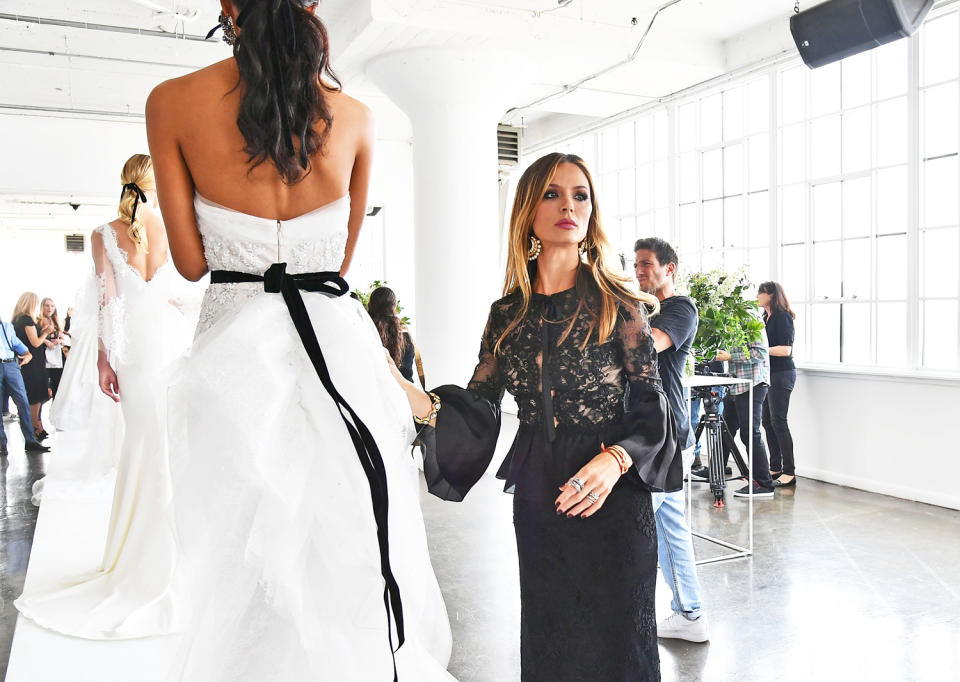We independently evaluate the products we review. When you buy via links on our site, we may receive compensation. Read more about how we vet products and deals.
What to learn about trauma survival from Harvey Weinstein's ex-wife Georgina Chapman

When news broke last October that dozens of women were accusing Hollywood megaproducer Harvey Weinstein of sexual harassment and rape, the behemoth’s seemingly untouchable career crumbled. Collateral damage included his wife, Georgina Chapman, who soon thereafter announced she was leaving Weinstein.
Chapman, the co-founder of fashion brand Marchesa, said in a statement after the revelations surfaced that her “heart breaks for all the women who have suffered tremendous pain because of these unforgivable actions.” But she has otherwise remained out of the public eye, asking the media for privacy. Four months later, Chapman and Marchesa opted for private appointments with clients instead of a runway show, as had been customary for the label.
But that doesn’t mean she hasn’t been working tirelessly, according to a new interview Marchesa co-founder Keren Craig gave to Grazia.
“She threw herself into her work, she threw herself into protecting her kids. Marchesa is her life, it is her passion,” said Craig, who’s also godmother to Chapman’s children. “You see it here: Even though she was going through all that, these beautiful things have somehow come out of such a hard time.”

Does throwing yourself into work after a traumatic personal experience like divorce make sense for most people? In fashion, it can apparently spark breakthroughs, and not only for Chapman. Designer Maryam Nassir Zadeh announced in December that she and her husband (and business partner) were divorcing. Two months later, Zadeh presented a “spontaneous and confident — and undeniably provocative” collection during New York Fashion Week. Going back further, and more notably, there’s legendary designer Diane von Furstenberg, whose divorce from German Prince Egon von Furstenberg in 1972 reportedly led to the creation of DVF’s now-iconic wrap dress.
Of course, the Chapman-Weinstein divorce is subject to special circumstances not afforded to most people: The couple’s settlement, not including various marital assets, would pay Chapman between $15 and $20 million. So, the thinking goes, Chapman could continue at work, but financially, she wouldn’t have to, unlike many Americans who go through divorces (they’re expensive, after all).
Setting that aside, there’s a growing body of research exploring how art therapy may be good for easing the pain of trauma. Nancy Gerber, director of the PhD program in creative arts therapies at Drexel University, explains that expressive arts support trauma recovery, noting “the experience of traumatic events can be difficult to express in words,” and creative outlets, in this case designing, can be “the first step to get [the traumatized individual] feeling calmer and more creatively expressive.”

“Accounts of the challenges endured by creative individuals suggest that they may have been able to channel their negative experiences as sources of inspiration and motivation for their work,” according to a separate 2013 study. “Increased creativity may therefore constitute a manifestation of posttraumatic growth, defined as retrospective perceptions of positive psychological changes that take place following experiences of highly challenging life circumstances.”
Those working in creative fields are perhaps better positioned to channel their emotions constructively through work, though. Some experts think that it takes an individual two years to recover from emotional trauma, and that shortcuts toward emotional rehabilitation should be avoided. Certainly, it’s a case-by-case basis.
Mark Banschick, psychiatrist and author of The Intelligent Divorce: Taking Care of Your Children who also hosts free seminars on how to manage a divorce with children, tells Yahoo Lifestyle that while therapeutic behaviors like throwing yourself into art or work turn a passive process into a valuable, active and creative process, “trauma is trauma, and you can’t pretend it isn’t there.”
“It’s like a tsunami waiting to come out. Good therapy is essential. Eye Movement Desensitization and Reprocessing, supportive work, and other technologies can be very helpful,” Banschick says. “Never underestimate the value of healthy grief. It’s the best way to get to the other side.”
Read more from Yahoo Lifestyle:
Follow us on Instagram, Facebook, and Twitter for nonstop inspiration delivered fresh to your feed, every day.
